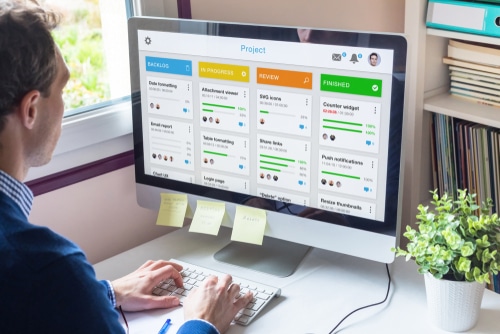The Essential Guide to Requirements Management
Published on: October 20th, 2022
Good requirements management is essential for successful product and software development. Engineering teams rely on error-free, concise, and clear requirements to identify errors early, meet stakeholder expectations, and reduce project risk and cost.
So, what exactly is requirements management? It is a set of techniques used to document, prioritize, analyze, and agree on project requirements. It allows engineering teams to gather, analyze, validate, and verify a product or software’s requirements to ensure that the project deliverables meet all stakeholder expectations.
Requirements management is essential in organizations. For instance, if stakeholders like support management, sales, customers, operations, and engineering generate different requirements; requirements management ensures clear communication and continuous adjustments during the entire project lifecycle.

This article gives you all the tools you need to get up to speed with requirements management including:
- How does it Work?
- Why Requirements Management is Important
- Advantages of Requirements Management
- Requirements Management Best Practices
- Requirements Management Tools for Azure DevOps
How Does it Work?
Requirements management aims to ensure a project meets all objectives successfully. Therefore, it provides a strategy for preventing errors during product development by monitoring and tracking changes in needs and requirements. It also fosters communication between stakeholders throughout a project’s engineering lifecycle.
While documents manage requirements, complex products or systems depend on trusted requirements management solutions and tools to mitigate risks. That being the case, requirements management often involves four phases:
- Planning: Based on the project’s scope, team roles, communication plan, assumptions, risks, and dependencies, you must create a plan for communicating and gathering requirements. Account for constraints of time, scope, and cost by establishing your project baseline. Be sure to include easy traceability, to help you track the common thread between stakeholder needs and product spec.
- Developing the requirements: Developing the project requirements involves collecting all known requirements, defining, organizing, and documenting them, and analyzing them to identify missing requirements.
- Validation and verification: When verifying the product design, you must ensure you have met all the goals. Activities like user testing validate the product functions per end-user needs and requirements.
- Change management: Requirements management is an ongoing process, so you need a process to gathering end-user data and manage required changes after product release.
See how it works:
Ready to streamline your requirements management today?
Why Requirements Management is Important
Technology advancements like the Internet of Things have changed how products and software work and how companies conduct their design and development processes. As engineering teams add more software components and lines of code to enable greater connectivity, products are becoming more sophisticated.
But with requirements management, developers can navigate the interdependencies and complexities in modern engineering lifecycles, thus structuring the development processes while accelerating product deployment.
Leveraging requirements management solutions and software provides engineering teams with the necessary tools for executing the project plan, minimizing costs, enhancing quality control, and speeding up the time to market.
Problems and challenges in requirements management are the top reasons many projects fail. For example, inadequately or inaccurately defined requirements may cause poor product quality, cost overruns, delays, and scope creep, leading to failure to meet stakeholder or customer needs.
That said, a requirements management plan is essential to ensuring the project’s success since it permits developers to control the development lifecycle and the project scope.

Advantages of Requirements Management
There are numerous requirements management benefits. Using a requirements management solution addresses the challenges, inefficiencies, and risks of managing documents using legacy systems and documents. In addition, a modern requirements management solution bridges the engineering silos in a product development lifecycle.
A requirements management solution also permits engineering teams to identify, analyze, trace, and manage requirements changes securely and centrally. As a result, it improves collaboration between different stakeholders, enhances traceability and transparency, extends usability, and reduces rework. A requirements management solution is vital since it strengthens project agility and simplifies regulations compliance.
A requirements management solution enhances a project development process due to advantages like:
- Enabling compliance and product quality
- Identifying and managing project risks
- Optimizing development processes and enhancing efficiency
- Ensuring understandability throughout the project lifecycle and effective change management
- Enhancing requirements monitoring, tracking, and traceability
- Accelerating product deployment and time to market
- Facilitating real-time communication, iteration, and collaboration
Requirements Management Best Practices
A product is satisfactory when it meets all the requirements that inspired its development. To do this, system engineering teams must have increased visibility into requirements changes and deeper insight into the product’s post-release data to inform the changes needed to enhance the user experience. Hence, the recommended requirements management best practices are:
- Enhanced traceability: Engineering teams must link the project’s artifacts to the individual test cases to increase the visibility of the engineering requirements changes in real time. The most efficient approach is capturing the annotations and ensuring they can be accessed easily to enhance traceability.
- Managing product variant process: Effective requirements management requires developers to manage the whole variant process and version of a system using a requirements management tool to provide a shared dashboard for monitoring its progression. It is also essential to store the data centrally to ensure it is accessible in an understandable format.
- Compliance with necessary regulations: For an efficient requirements management process, engineering teams should embed the necessary regulations and standards in the requirements themselves. Engineering compliance ensures compliance by design.
Integrating compliance throughout the engineering lifecycle also prevents non-compliance risks while making the compliance process less challenging. - Agile management: of the product requirements fosters collaboration between different teams worldwide. A requirements management solution provides a single source of truth for requirements changes, enabling different teams to incorporate these changes effortlessly.

Requirements Management Tools for Azure DevOps
Modern Requirements help turn your Azure DevOps project into a collaborative workspace and eliminates the old copy/paste-based manual processes. You can now create, automate, manage, analyze, and report directly from your project. These modern requirements management tools provide a single source of truth that is fully embedded within Azure DevOps. They extend your project into a full RM Solution.
Our tools allow your teams to take any approach to create requirements, whether by diagrams or documents. Every requirement you create will exist directly within your Azure DevOps project.
Bring Stakeholders and team members together by allowing them to collaborate within the same space. Build online requirements reviews directly from within your project. Invite Stakeholders and team members alike to request and facilitate change. Baseline your requirements before and after reviews to capture changing requirements quickly and easily. Create Traceability Matrices in under a minute that allow you to capture end-to-end traceability easily.
Ready to get started with requirements management for your organization? Contact us for a quote or for more information.


